Keyword research is a fundamental aspect of search engine optimization. Before trying to rank for key search terms, you need to verify that those terms have value to your brand. For instance, what is the monthly search volume? What is the search intent for those keywords?
You also need to determine if your site actually has a chance of ranking on Page 1 for those terms. A keyword with a Moz difficulty score of 77 will be really hard to rank for if your site has a Domain Authority of 55.
Thankfully, tools like Ahrefs, Moz Keyword Explorer and SEMrush provide us with all that data, and give us some guidance.
Sort of …
The inherent flaw with most keyword research data is that it lags by a few months. Normally, that isn’t much of an issue. You can see from this Ahrefs data, for instance, that search volume and click-through rate for the keyword “digital marketing” has been relatively stable between March 2017 and December 2019:

But when something extraordinary happens – something that fundamentally changes life for hundreds of millions of people and sends normal market demands into unprecedented tailspins, something like COVID-19 – that slight lag suddenly becomes super important.
Search engine results pages (SERPs) start to see wild fluctuations as the web becomes flooded with new content pertaining to the pandemic.
Search activity, meanwhile, experiences seismic shifts, as people ask entirely new questions like “how to do marketing during a pandemic.”
And unfortunately, we’re blind to a lot of this activity because keyword data hasn’t caught up. Case in point, SEMrush isn’t even showing us the SERPs for the long-tail keyword “marketing during a pandemic:”

What’s equally frustrating is that, by the time that data actually becomes available, the world may already have changed significantly again (because let’s face it – none of us really know what two months from now looks like).
It’s quite a pickle, and it leaves a lot of digital marketers with a big question on their hands:
“Should I even bother with keyword research right now?”
The answer: Yes, but with a different set of goals
We normally use tools like Ahrefs to create long lists of keywords. We then export those lists into spreadsheets where we can sift through them and cherry-pick the search terms we want based on their volume and difficulty.
The idea is that we let data lead our creatives.
But data can’t tell us how to create content for a pandemic-stricken audience, because like we said, there is no data.
Therefore, doing keyword research as you normally would, and writing articles based on those keywords is risky. You could waste a lot of time and money targeting a keyword that appears to be within striking distance, but has since become very much out of reach for your company.
For instance, can you imagine how fiercely competitive a term like “video conferencing software” actually is right now? As of December 2019, it had a monthly U.S. search volume of 1,800 and a difficulty score of 60.
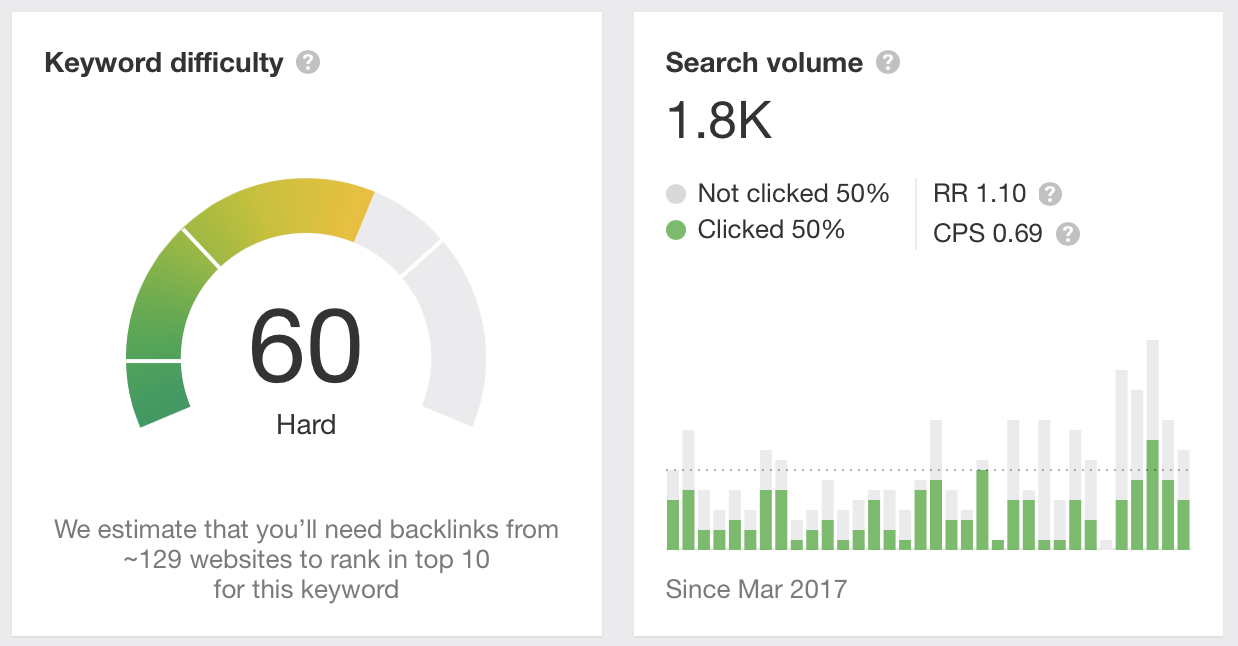
I would bet my life savings that it’s currently way higher and much more difficult than is reflected in the latest data.
In fact, mere minutes after I took the above screenshot, I refreshed the latest SERP and keyword difficulty and data and took a second screenshot. Notice anything different?:
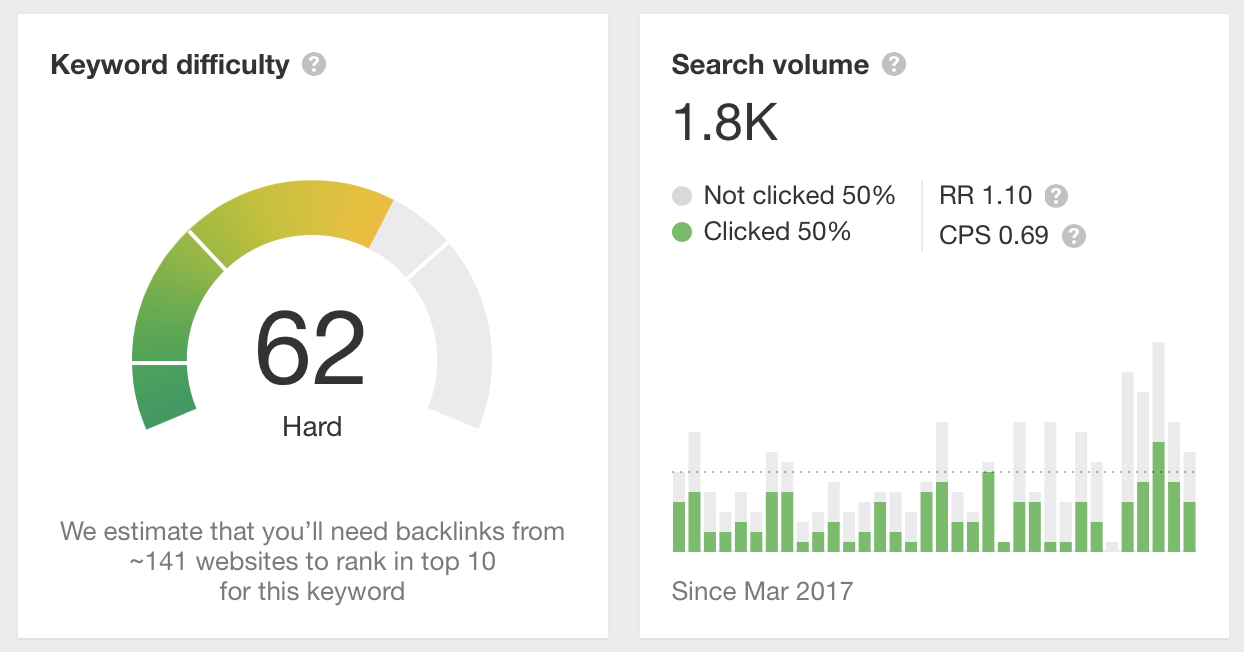
Yeah.
In the time it takes me to write a few sentences, the keyword difficulty score increased by 2 points, and the number of estimated website backlinks needed to rank well for this term jumped from 129 to 141. It’ll probably only go up from here, like so many other keywords, while others – such as “car rental insurance” – bottom out.
The point is, this is not keyword research as usual.
What you should do instead
In no particular order:
1. Use common sense and intuition
You know as well as anyone what industries have been disrupted, for better or for worse. Air travel and hospitality are obviously hurting, while software and e-commerce are getting more business.
And you can inuit what that could mean for monthly search volume and keyword difficulty. You can also use common sense to figure out that some keywords, regardless of how difficult, are worth your time to target.
For instance, let’s say you sell video conferencing software.
Will it be easy to rank on Page 1 right now? That depends on your Domain Authority and that of your top competitors, and how close you were to the coveted No. 1 spot before this all went down. The rules haven’t changed; the playing field has.
Either way, a keyword that has very clear commercial intent for your business is probably worth targeting even during a pandemic. Or at the very least, commercial-intent keywords you’re already ranking well for are worth maintaining.
Which brings us to the next thing you should do:
2. Monitor your commercial-intent keywords on Google Search Console
Rain, shine or pandemic, you need to rank well for commercial-intent keywords.
These are the keywords that indicate a user is shopping. “How to enable camera access” tells a different story than someone who types “video conferencing software” into a search bar.
And even if your industry is seeing a decline in demand, you need to make sure your position isn’t slipping for those commercial-intent keywords, because:
- This pandemic won’t go on forever, and when demand increases, you want to be well-positioned for the rebound.
- Commercial-intent keywords are your site’s bread and butter. You need to maintain your ranking for them, especially if fewer people are searching for them because of the pandemic (because that means fewer conversion opportunities).
- The nice thing about commercial-intent keywords is that the true buying intent for them does not frequently see drastic changes. Video conferencing software is still going to be called video conferencing software by the time this pandemic has passed – even if some of the long-tail questions being asked around it change.
Google Search Console is the best way to monitor those commercial-intent keywords.
At Brafton, for example, we’ve chosen to target commercial-intent keywords that contain “services” in them, like “content marketing services” and “animation services.” These are keywords that someone who is shopping around will likely use.
We can closely track our grip on those keywords by looking at our average position in Search Console for queries containing “services”:

The data shows us nothing alarming over the past 3 months, and the most recent data indicates an increase in our average position.
You can do the same sort of exercise for your company. As you monitor your commercial intent keywords in Search Console, keep the following in mind:
- Look for anomalies – the occasional rise and fall here and there is to be expected, but any prolonged slopes (more than a month) are cause for concern.
- Compare your data from this time period to last year’s data from the same period to get a sense if any declines are seasonal, and see year-over-year changes.
Search Console Pro Tip
Be mindful of how circumstances other than the coronavirus affect average position changes.
For instance, we saw this in Search Console when we compared average position of the last 3 months year-over-year:
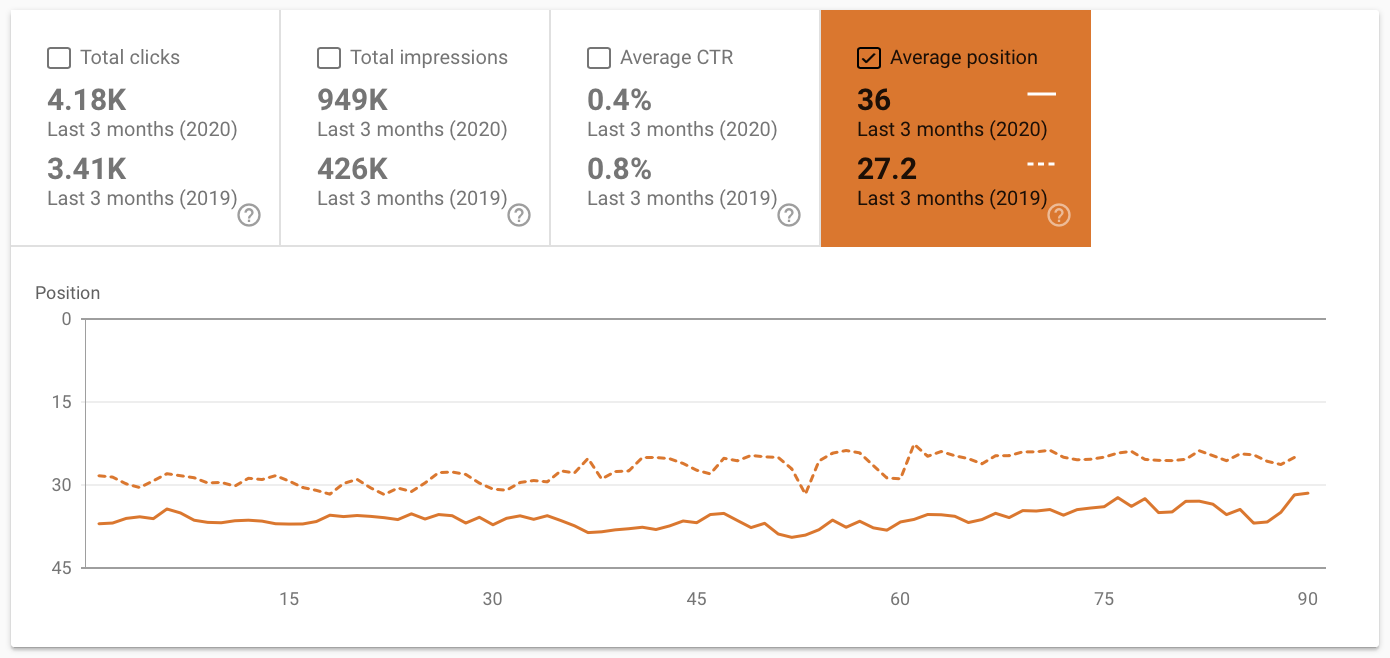
At first glance, it looks like we were actually doing better last year (the dotted line) than this year (the solid line). But in actuality, this all has nothing to do with the coronavirus.
We optimized and created a bunch of landing pages in Q1 of 2020. As a result, we are now ranking poorly for a ton of new keywords that we weren’t ranking for at all last year. We can prove this by doing a year-over-year comparison for the number of search results our site is showing up in (impressions):
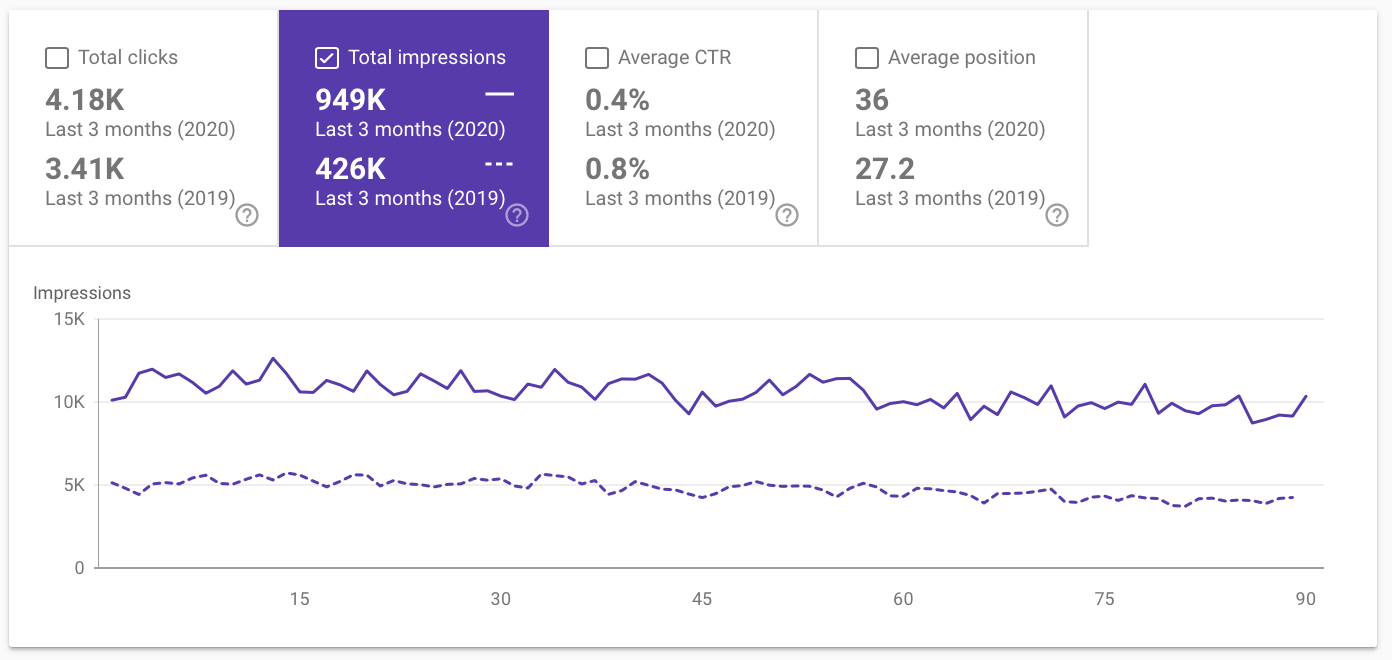
As you can see, we have way more impressions this year than last – twice as many!
Which means we should technically also be starting to see more clicks:
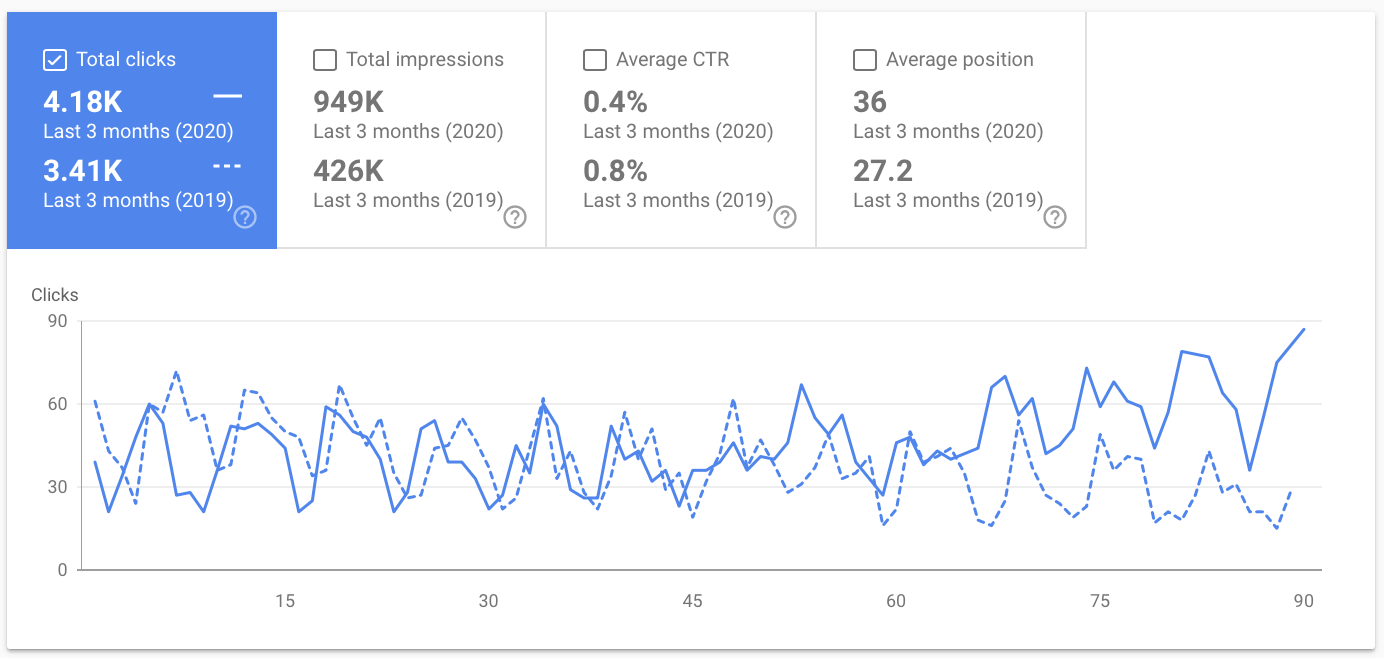
And what do you know? Clicks are on the rise. Phew. If all goes as planned, our average position should also increase in the next few months, as we start to rank better for more keywords.
The bottom line: It’s really easy to draw overly simplistic conclusions in Search Console, especially if you’re new to it. But even if you are a newbie, it’s crucial that you keep a hawk’s eye on your commercial keywords. If you start to see your ranking slip, it may be time to re-optimize your commercial landing pages.
3. Look at Google Analytics, Google Trends and other live data
If you’ve historically used keyword research to help you with topic ideation, rest assured: There are other ways to use search data to guide content creation. Here are just a few, completely free resources:
Google Analytics
It sort of goes without saying, but keep a close eye on what pages are performing well in Google Analytics, what the source of the traffic is and what queries are generating that traffic (if organic search is a key source). This can provide clues, if nothing else, about what type of content people value right now.
Google Trends
Type in a subject or keyword, and see what relative search interest in that term is. It won’t tell you anything about keyword difficulty, but the data is pulled in real time.
Google Autocomplete
Open a private window, and start typing in commercially relevant search terms to see how Google automatically completes the query. You can start broad, with one-word terms (e.g., marketing), and then slowly add additional words to try to get a sense for what Google recommends. Experiment with various topics and keywords that are relevant to your company.
Soovle
Google autocomplete on steroids basically. You’ll see what I mean.
To reiterate, these methods won’t give you much in the way of highly specific, strategic data. But they may help confirm some of your hunches as you explore what type of content is most useful for your audience right now.
Speaking of which:
4. When in doubt, prioritize your audience over keyword rankings
You should always be empathizing with your target audience, but it’s even more important during a pandemic to put yourself in their shoes.
And that might mean scaling back on your usual content and SEO tactics so you can focus more time and energy on being a source of helpful information for your audience right now.
Because again, there’s only so much that data you can tell you about creating content for a pandemic-stricken audience.
Your best compass is your instincts as a communicator, and your sense of empathy as a human being living through a crisis.
In a lot of ways, you’re more aligned with your audience now because of this shared experience.
That advantage might lack the precision of your usual data-driven tactics, but it’s no less powerful.





